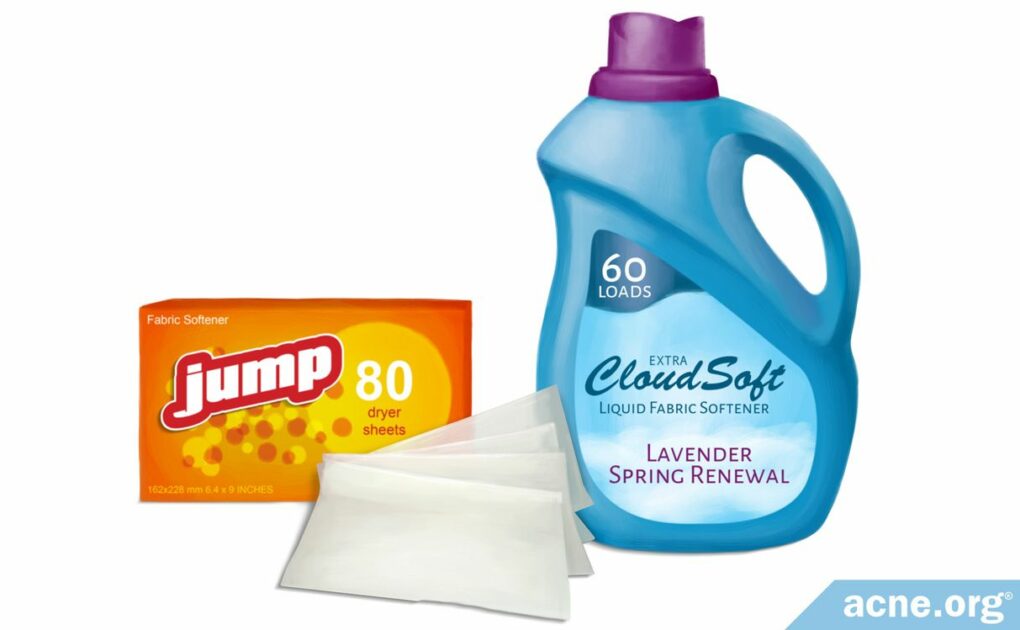It Is Unknown, so It May Be Best to Use Alternatives Like Wool or Plastic Anti-static Dryer Balls

The Essential Info
Fabric softeners are products used after laundry is washed to make clothing feel softer and reduce static cling, wrinkling, and drying time.
Some people are concerned that the fabric softener that is left on clothing will come into contact with the skin, particularly the skin on the body, and lead to clogged pores and breakouts. However, no studies have been performed on specific fabric softener chemicals, and because fabric softener manufacturers are not required to include a full ingredient list on the package, it is difficult to determine whether any of the other ingredients could be problematic.
Fragrances: Fragrances can cause skin irritation in about 5% of people, and people with acne already have irritated skin. Could the strong fragrances in fabric softener add to this irritation? It could be a possibility.
Oils & Fats In Some Fabric Softeners: Some oils and fats used in some fabric softeners have been shown to clog pores, such as coconut oil and cocoa butter. However, because most fabric softeners do not have a full ingredient list, it is difficult to determine whether the fabric softener you are using contains any of these problematic oils and fats. Even if your fabric softener does contain one or more of these ingredients, it is also difficult to know whether the small amount of fabric softener left on clothing would be enough to lead to clogged pores.
The Bottom Line – Use Alternatives Instead: Since there are open questions, out of an abundance of caution, it may be prudent for people with acne to forgo fabric softener. Instead, try anti-static dryer balls.

The Science
- All about Fabric Softeners
- Do Fabric Softeners Cause or Worsen Acne?
- Ingredients Found in Fabric Softeners
- Are Fabric Softener Ingredients Comedogenic (Pore-clogging)?
- Do Fabric Softener Ingredients Irritate the Skin?
- Alternatives to Fabric Softeners
- The Bottom Line
All about Fabric Softeners
Fabric softeners, also called fabric conditioners, are products used to make laundry and clothes feel softer to the touch in addition to decreasing static cling, wrinkling, and drying time. They are used after clothes are washed.
Washing clothes in a washing machine causes the fibers in the clothes, especially cotton and wool fibers, to tighten. Fabric softeners work by coating these fibers with lubricating and anti-static chemicals, and this causes the fibers in clothes to relax and soften.
There are two types of fabric softeners:
- Liquid: Goes into the washing machine during the rinse cycle
- Dryer sheet: Goes into the dryer
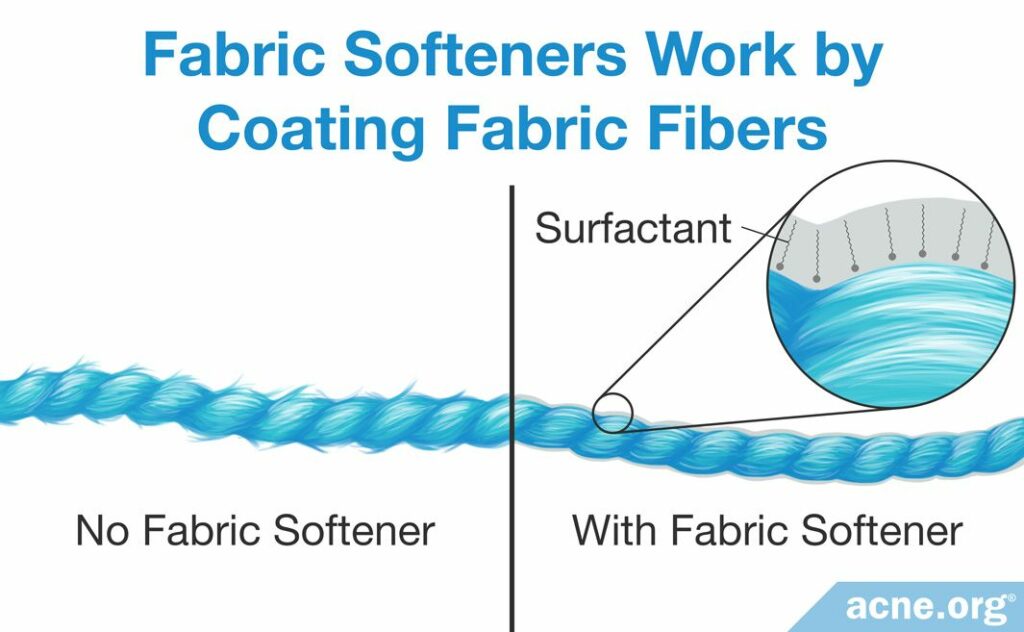
Do Fabric Softeners Cause or Worsen Acne?
There are no studies investigating whether fabric softeners cause or worsen acne. Normally, when we encounter that sort of obstacle, we would then look for other clues, such as studies investigating the specific ingredients in fabric softeners. However, when it comes to fabric softener, there are also no studies that look at whether fabric-softening chemicals clog pores. So, as we sometimes have to admit in science, we simply don’t know yet.
However, fabric softeners often contain fragrances, and fragrances can sometimes cause irritation, especially in people with sensitive skin.1,2
Ingredients Found in Fabric Softeners
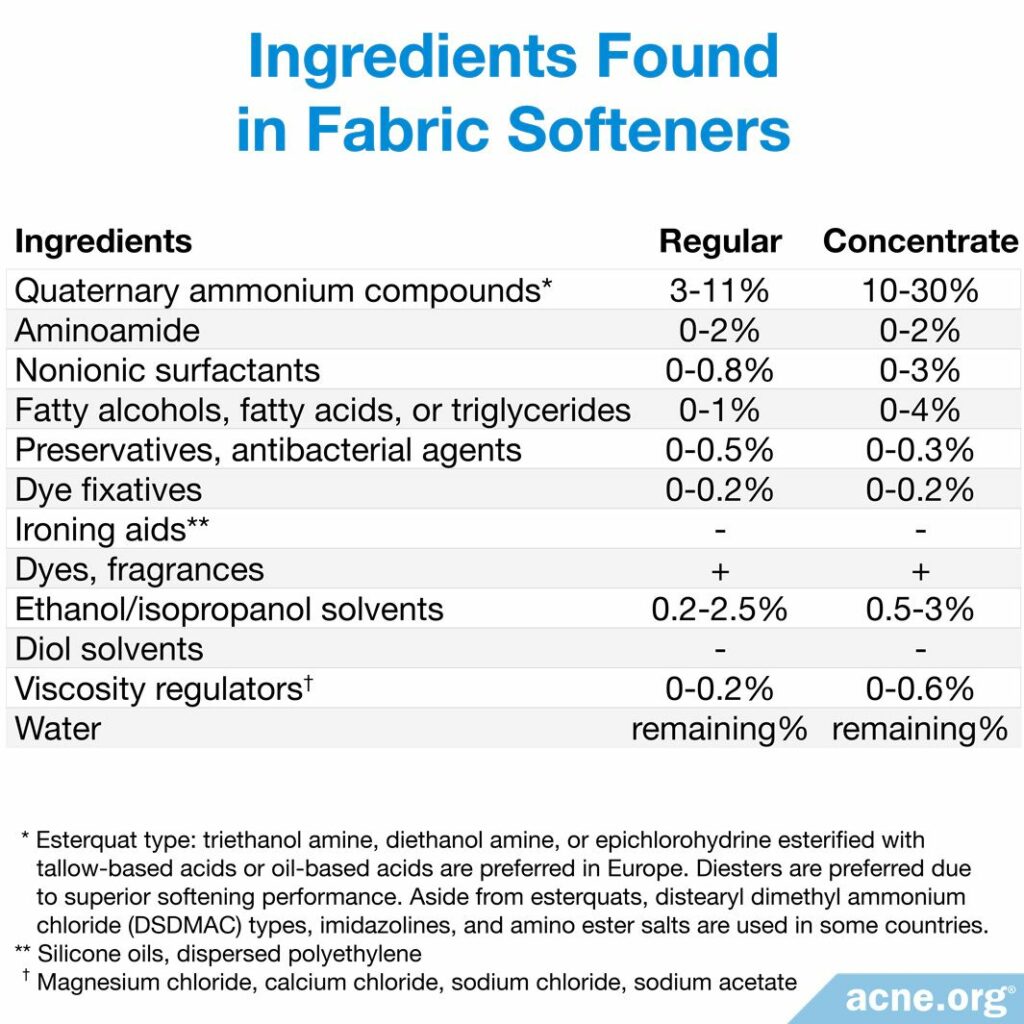
There are two main classes of ingredients commonly found in fabric softeners that work to soften fabrics. They are generally found in concentrations ranging from 4 – 30% in fabric softeners. These include:
- Quaternary ammonium compounds: These are the main fabric softening ingredients. They include substances like diethanolamine, triethanol amine esterquats, distearyl dimethyl ammonium chloride, imidazolines, and dipalmitoyethyl hydroxy ethylmonium methosulfate.
- Fatty alcohols, fatty acids, or triglycerides: These chemicals are added to fabric softeners to increase their softening capability. Examples of substances in this class include oils, waxes, and fats.
Besides the main ingredients that soften fabrics, fabric softeners may contain other ingredients that serve as ironing aids, preservatives, dyes, and/or fragrances.
Are Fabric Softener Ingredients Comedogenic (Pore-clogging)?
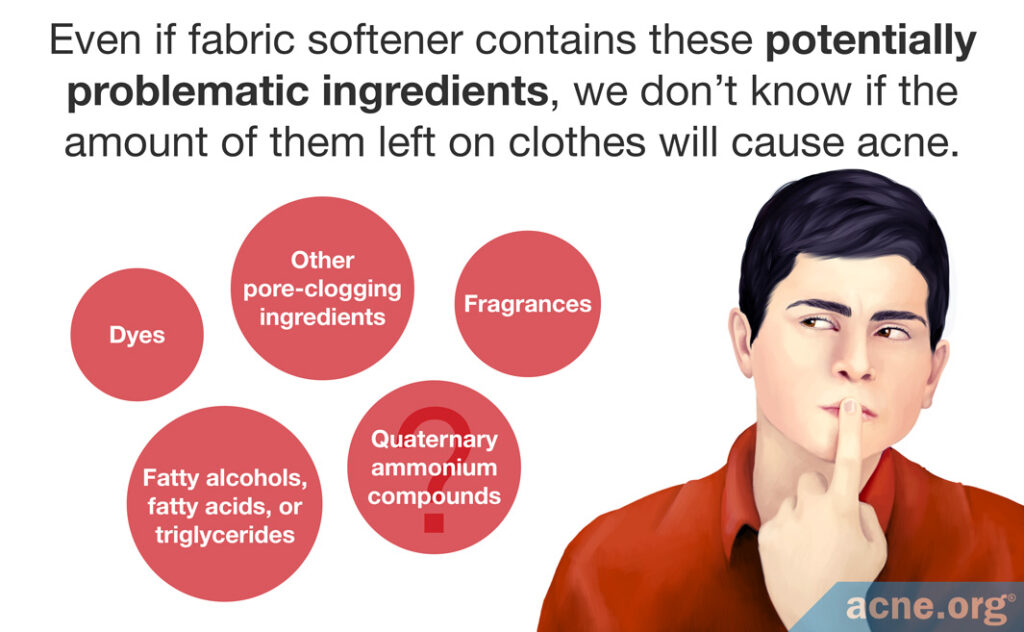
The two main classes of fabric softener ingredients differ in terms of their known ability to clog pores:
- Quaternary ammonium compounds: Scientists have not performed studies investigating the comedogenicity of these compounds. So, we do not know whether they are comedogenic.
- Fatty alcohols, fatty acids, or triglycerides: Some fatty acid compounds used in skin care products and fabric softeners are comedogenic, for example, linseed oil, coconut oil, and cocoa butter. However, fabric softener manufacturers almost never list the types of fatty acids used in their products, so it is impossible to know whether fabric softeners contain comedogenic fatty acids or non-comedogenic fatty acids.
Other ingredients found in fabric softeners may also be comedogenic. Some additional comedogenic ingredients found in fabric softeners may include lanolin alcohol, myristyl myristate, oleyl alcohol, octyl palmitate, and cetyl acetate.
Therefore, it is likely that some fabric softeners contain comedogenic ingredients, though it is impossible to know for sure which products contain comedogenic ingredients and which do not.2,4
Note: We do not know whether the amount of potentially comedogenic ingredients transferred to the skin through fabric softeners on clothing is enough to cause clogged pores. This means that even if a fabric softener contains a comedogenic ingredient, it may not be enough to cause clogged pores in humans.2
Do Fabric Softener Ingredients Irritate the Skin?
Researchers caution that some fabric softeners have the potential to cause itchiness in the skin. One of the most common irritants in fabric softeners are fragrances, which are well-known skin irritants for some people. When given the option of using products with fragrance or without, people with acne-prone/sensitive skin should try to opt for products without fragrance.7-9
Expand to read ingredients of liquid fabric softeners
Examples of fabric softeners: softening agents are in red.
– Ultra-Downy® April Fresh® Liquid Fabric Conditioner – Water (Process aid), Diethyl ester dimethyl ammonium chloride (Softening agent), Fragrance, Calcium Chloride (Process aid), Formic acid (pH modifier), Hydrochloric acid (pH modifier), Dye (colorant), Polydimethylsiloxane (Process aid), Methylisothiazolinone / Methylchloroisothiazolinone (Preservative), Cationic polymer (Structuring agent), Diethylenetriamine pentaacetate, sodium salt (Chelator)
Our comments: There is not enough data about comedogenicity of ingredients used in this product.This product contains fragrances which may be irritating for some people.
– Classic Purex® Fabric Softener Mountain breeze – Water, Quaternary Ammonia Compound, Dimethicone, Methylisothisothiazolinone, Fragrance, Liquitint Royal MC, Lilial
Our comments: There is not enough data about comedogenicity of ingredients used in this product. This product contains fragrances which may be irritating for some people.
– ATTITUDE® Natural Fabric Softener Fragrance-free – Aqua / water / eau, vegetable cationic surfactant / agent tensioactif cationique végétal (dipalmitoylethyl hydroxyethylmonium methosulfate), glycerin, caprylyl glucoside, myristyl glucoside, triethyl citrate, raspberry ketone, avena sativa kernel flour (colloidal oatmeal / avoine), allyl caproate
Our comments: This product is fragrance-free so it probably should be fine. Still, there is not enough data about comedogenicity of ingredients used in this product.
Expand to read ingredients of dryer sheets
Examples of fabric softeners: softening agents are in red.
– Ultra Downy® Infusions™ Botanical Mist™ Fabric Softener Sheets – Dipalmethyl Hydroxyethylammoinum Methosulfate (Softening and Antistatic agent), Fatty Acid (Softening Agent), Polyester Substrate (Carrier), Clay (Rheology Modifier), Fragrance (Fragrance)
Our comments: This product contains fragrances which may be irritating for some people. However, there is not enough data about comedogenicity of ingredients used in this product. For example, we do not know the exact type of fatty acid used here (and we know that some fatty acids may be comedogenic).
– Bounce® Dryer Sheets Fresh linen – Dipalmethyl Hydroxyethylammoinum Methosulfate (Softening and Antistatic agent), Fatty Acid (Softening Agent), Polyester Substrate (Carrier), Clay (Rheology Modifier)
Our comments: This product is fragrance-free so it probably should be fine. However, there is not enough data about comedogenicity of ingredients used in this product. For example, we do not know the exact type of fatty acid used here (and we know that some fatty acids may be comedogenic).
– Gain® Dryer Sheets Apple Mango Tango – Dipalmethyl Hydroxyethylammoinum Methosulfate (Softening and Antistatic agent), Fatty Acid (Softening Agent), Polyester Substrate (Carrier), Clay (Rheology Modifier), Fragrance (Fragrance)
Our comments: This product contains fragrances which may be irritating for some people.However, there is not enough data about comedogenicity of ingredients used in this product. For example, we do not know the exact type of fatty acid used (and we know that some fatty acids may be comedogenic).
Alternatives to Fabric Softeners
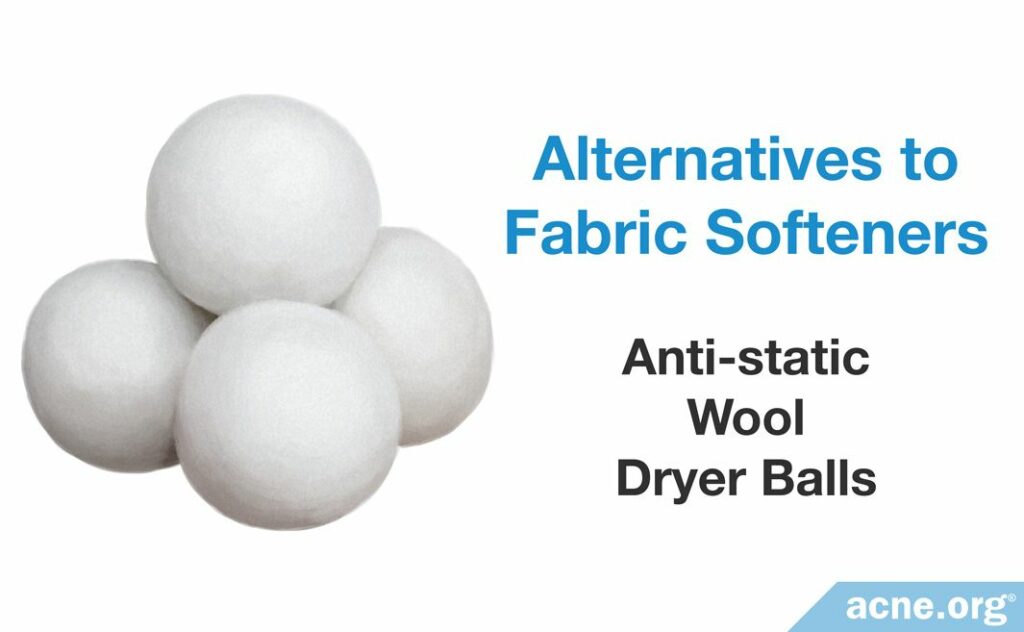
One benefit of fabric softeners is that they reduce rubbing of fabrics against the skin. A 2011 study published in The Journal of Dermatology found that using fabric softener helps prevent dry skin, likely by reducing rubbing of clothing against the skin.10 However, you can obtain the same benefits without using traditional fabric softeners. There are chemical-free alternatives to fabric softeners that will soften fabric and reduce static, but will not cause more acne or skin irritation. These alternatives are called dryer balls, which are wool or plastic balls that are added to the dryer to soften fabrics.
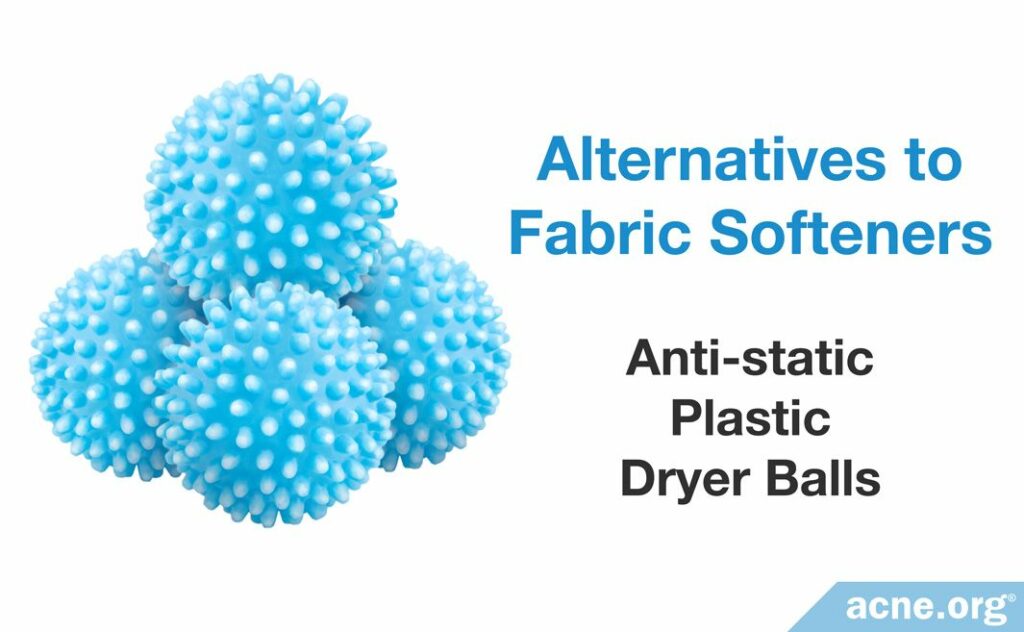
In addition to the dryer balls, another alternative for reducing static cling is to use a crumpled piece of aluminum foil in the dryer.
The Bottom Line
Since we don’t know whether fabric softeners can contribute to body acne, it is best to simply not use them if you are prone to getting acne on your body. If you still want to use something to reduce static cling, wrinkling, and drying time, try using dryer balls instead.
References
- Fabric softener, https://en.wikipedia.org/wiki/Fabric_softener Accessed on 18/11/2017.
- Smulders, E. & Sung, E. Laundry Detergents, 2. Ingredients and Products. In: Ullmann’s Encyclopedia of Industrial Chemistry. pp. 443 – 444 (Wiley). https://onlinelibrary.wiley.com/doi/abs/10.1002/14356007.a08_315
- Katoulis, A. C., Kakepis, E. M., Kintziou, H., Kakepis, M. E. & Stavrianeas, N. G. Comedogenicity of cosmetics: a review. J Eur Acad Dermatol Venereol 7, 115 – 119 (1996). https://www.ncbi.nlm.nih.gov/pubmed/6229554
- Hellalllt, B., Simon, C. & Ugazlo, S. Process for preparing fabric softener compositions. US Patents. Patent number: US 8,242,071 B2. Available from: http://www.google.sr/patents/US8242071.
- Quaternary ammonium cation, https://en.wikipedia.org/wiki/Quaternary_ammonium_cation Accessed on 19/11/2017.
- Reich, C. & Su, D. T. Hair conditioners. In: Handbook of Cosmetic Science and Technology. pp. 331 – 346 (Informa Healthcare, 2009). http://61.188.205.38:8081/hxgcx/hcjs/UploadFiles/pdf/文献库/模块10化妆品/Handbook of Cosmetic Science and Technology 3rd ed.pdf
- Robinson, M. K. et al. Comparative assessment of the acute skin irritation potential of detergent formulations using a novel human 4-h patch test method. Food Chem Toxicol 43, 1703 – 12 (2005). https://www.ncbi.nlm.nih.gov/pubmed/16026914
- PDQ Supportive and Palliative Care Editorial Board. Pruritus (PDQ®): Health Professional Version. 2020 Feb 25. In: PDQ Cancer Information Summaries [Internet]. Bethesda (MD): National Cancer Institute (US); 2002-. https://www.ncbi.nlm.nih.gov/books/NBK65789/
- Żukiewicz-Sobczak, W. A. et al. Allergy to selected cosmetic ingredients. Postepy Dermatol Alergol 30, 307 – 310 (2013). https://www.ncbi.nlm.nih.gov/pmc/articles/PMC3858659/
- Isoda, K., Takagi, Y, Kitahara, T., Sano, Y., Sugano, I., Umeda-Togami, K., Umeda, K., Yamanaka, K., Yamada, T. & Mizutani, H. Treatment of cloth with a fabric softener ameliorates skin dryness. J. Dermatol. 38, 685-392 (2011). https://www.ncbi.nlm.nih.gov/pubmed/21729145
